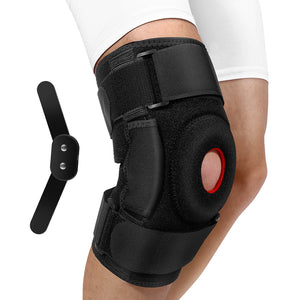Hip vs. Waist Measurement: How to Measure Waist and Hips

Measuring hip vs. waist measurement is essential in fitness. It is crucial for selecting the right gear, monitoring health effectively, and setting and achieving specific fitness goals. Observing changes in these measurements can motivate us to stay committed to our fitness journey, boosting our drive and confidence.
However, most people are unaware of this body circumference analysis. This article will guide you through the process with step-by-step instructions for each measurement stage.

Preparation for Measurement
The first step in evaluating your body composition is mentally and physically preparing for measurement. This involves choosing the right tools and appropriate time. This way, you can accurately measure the waist or hip and get an ideal composition metric of your body. Here are simple instructions that you can follow when preparing for measurement:
1. Measuring Time
Before you begin hip vs. waist measurement, it’s crucial to start at a suitable time. Generally, healthcare experts recommend early morning or immediately after you wake up. This is because you are on an empty stomach, with fewer chances of bloating or distending the stomach. Moreover, measuring at the same time of the day maintains a consistent baseline and results in accurate body measurements.
2. Dress Suggestion
When measuring hip and waist, many people get confused about what to wear and what not. For precise results, it is best to wear tight clothes or roll them when doing waist measurements. The purpose is to measure against your skin, so a thin and slim dressing is often preferred by experts. This ensures you don’t add extra inches due to thick clothes or heavy dress layers.
3. Selection of Tools
For all the possible reasons, you should know what tools you need for an accurate hip vs. waist measurement. Enlisted below are some essential tools that you should have for accurate body composition analysis:
- A flexible measuring tape
- Paper and pencil to record measurements
- A full-length mirror for accurate body position
How to Measure Waist Size
At this point, you are prepared for the measurement. So, what’s the next step? The real challenge lies in how or where to measure waist and hips. To answer this, let’s first start with the waist measurement:
Step #1 Adjusting the Posture
When measuring the waist alone, maintain a correct posture. Stand upright with your feet together and your weight evenly distributed on both legs.
Step #2 Locate the Waist
The next step is to find your natural waistline. It should be located at the narrowest part of your torso, usually just above your belly button and below your ribcage.
Step #3 Wrap the Measuring Tape
In hip vs. waist measurement, the most essential stage is to wrap the tape measure so it perfectly fits with your body dimensions. Hold one end of the measuring tape at your navel and wrap it around your waist. You can look into the mirror to see if the tape is leveled on all sides.
Step #4 Record the Measurements
The next and final step is to note down the measurements with a pen or pencil. Take a piece of paper and write the final results in a quarter inch or half centimeters.
How to Measure Hip Size?
Now that you know all the strategies and instructions for measuring waist circumference, you might question how to measure hip size. There is nothing to worry about, as the instructions are somewhat similar and have a few basic differences. What are these? Let’s quickly see the step-by-step guide below:
Step #1 Maintain an Upright Position
Begin by adjusting your body posture and hip position. Stand upright such that your feet are joined together and weight is evenly distributed.
Step #2 Find the Hips
The next step is to find where the fullest part of your hips is located. Usually, they are found at the widest part of your buttocks or around the hip bones and bottom area.
Step #3 Take Measurements
Hold one end of the measuring tape at one side of your hip and wrap it around the widest part. This is a similar step in hip vs. waist measurement and requires that the tape is parallel to the floor for accurate analysis.
Step #4 Record the Final Results
Finally, it’s time to see the measurement results. Take a pencil and paper to jot down the important hip measurements and estimate your body health.
Precautions for Measurement
At this stage, you clearly know how to measure waist and hip circumference. However, this demands attention to detail to accurately evaluate your body composition. Therefore, here are some precautions you can take when doing the much-needed hip vs. waist measurement.
1. Avoid Tension
The first preventive measure is to relax your body and stay in a balanced or natural position. Say goodbye to tension, and do not pressure your muscles, as it can lead to inaccurate measurements. When taking and recording assessments, breathe out normally and do not tense your muscles.
2. Keep your Eyes Parallel to the Tape Measure
An important thing when doing the hip vs. waist measurement is to keep your eyes parallel to the measuring tape. Check in the mirror to see if the tape measure is leveled and perfectly wrapped around your waist or hip. Keep your eyes at the same height as your hips or waist for precise body evaluation.
3. Multiple Measurements
For natural waist measurement, measuring at the same time of the day, especially in the mornings, is advised. Consistent timing helps in precise analysis without the risk of errors or incorrect measurements. This also helps in data tracking as you can easily identify measurement points and evaluate your body's health.
What is Waist to Hip Ratio?
Besides knowing the difference between hip vs. waist measurement, it’s crucial to know what a waist-to-hip ratio means. It is the dimensionless ratio of the waist to the hip that calculates your overall body health. To measure your waist-to-hip ratio, simply divide the circumference of your waist by the circumference of your hips.
For example, a person with a waist of 75cm and a hip of 95 cm will have a 0.79 waist-hip ratio. It’s as simple as it sounds. Here is how the waist-to-hip ratio is associated with various health factors:
- The healthcare and medical industry gave insights into how a person’s body shape and size are associated with deadly health disorders such as obesity and diabetes.
- Traditional tools were implied to explore the link between body weight and metabolic imbalances.
- The hip size vs. waist size is a useful health metric, but a comprehensive health assessment requires it to be combined with other data such as blood pressure, BMI, and cholesterol levels.
Waist-to-hip ratio chart[1]:

Hip vs. waist measurement is a clear indicator of how your. It helps people easily measure their health and track their fitness without the need for invasive treatments or surgeries. If you will need to use the back support for your waist in the future, knowing your waist size can help you better select the appropriate size and style. Moreover, these measurements make it easy to select and purchase fitness protection products. Visit and embrace more Fivali products with your measurements and health goals in mind.
Reference:
[1] What Is the Waist-to-Hip Ratio? Available at: https://www.healthline.com/health/waist-to-hip-ratio (Accessed: 29 May 2024.
-
Posted in
Healthy Lifestyle, Joint, Recovery













